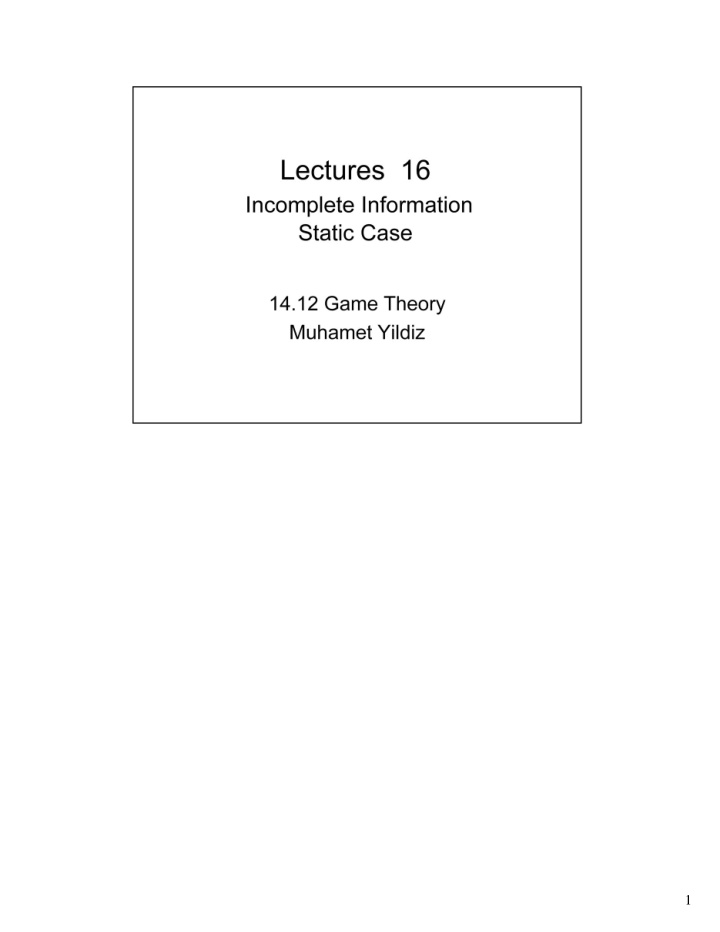



Lectures 16 Incomplete Information Static Case 14.12 Game Theory Muhamet Yildiz 1
Road Map 1. Example 2. Bayesian Games 3. Bayesian Nash Equilibrium 4. More Examples 5. Bayes' Rule 2
Incomplete information one player knows something (relevant) that some other player does not know. 3
Example (2 , 2) Work W Firm Hir ~ (0 , 1) Highp Do not Nature (0 , 0) hire (1 , 1) War W Low 1- Hire ~ (-1 , 2) Do not hire (0, 0) 4
Bayesian Game (Normal Form) A Bayesian game is a list G = {A 1 ,··· ,An; T 1 ,···, T n ;P1,··· 'Pn;U 1 '··· 'Un} where • A; is the action space of i (a; in A;) • T; is the type space of i (t; in T;) • p;(t;lt;) is fs belief about the other players • u;(a 1, ... ,a n ;t1, ... ,tn) is i's payoff. 5
~ ~ An Example Wor (1 , 2) TF irm ={tf}; W Tw = Finn {High,Low} A Fi rm = {Hire, Don't} Aw = {Work,Shirk} (0, 1) Highp PF(High) = P Nattrre Do no! (0,0) PF(Low) = 1-p hire (I, 1) ffv{tr)? / W Wor Low - Hire (-1,2) Dono! hire (0 , 0) 6
~>J : (tl S Bayesian Nash equilibrium A Bayesian Nash equilibrium is a Nash equilibrium of a Bayesian game (when each type has positive prob). • Bayesian game G = {A 1,···,An;T1'···' T n ;P1, ... ,pn;u1, ... ,un} • a strategy of i is any function s;: T; ---j- Ai; , S1 ') is a Bayesian • A strategy profile s* = (S1 ', ... Nash equilibrium ~ s; ' (t;) is a best response to s_; ' for each t; i.e ., ), ... ,s : I tJ max . ), ... ,S ;· _I (t H ),Q ; ,S ; + I (t ; + 1 (t,,};t )p ; (t _ ; OiEA; t _iE T_i 7
~ ~ An Example Wor (1 , 2) T Firm ={tf}; W w = Finn T {High, Low} AF irm = {Hire, Don't} Aw = {Work, Shirk} (0, 1) Highp PF(High) = P >1 12 Nattrr e Do no! (0,0) PF(Low) = 1-p hire (I, 1 ) W Wor = Hire SF* Low - Hire sw* (High) = Work Sw * (Low) = Shirk ( -1 ,2) Dono! Another hire (0 , 0) equilibrium? 8
Another example • 8 E {0 2}, known by Player 1 , L R • Y E {1,3}, known by Player 1 x 8,y 1,2 • All values are equally likely • T[ = {0,2}; T2 = {1,3} Y -1,y 8,0 • Bayesian Nash Equilibrium: • s[(O)= • s[(2)= • S 2(1) = • si3) = 9
Bayes'Rule Prob(A and B) • Prob(AIB) = Prob(B) • Prob(AIB)Prob(B) = Prob(A and B) = Prob(BIA)Prob(A) Prob(BIA)Prob(A) • Prob(AIB) Prob(B) 10
Example = p • Pr(WorkISuccess) Work Success J.l 1-p • Pr(WorkIFailure) = 1-p Failure Party p I- J.l 11
~ 0.9 P(WIS) 0.8 0.7 u:- 0.6 5: iL --' 0.5 P(WIF) (fJ ~ iL 0.4 0.3 0.2 0.1 0 0.2 0.6 0.8 0 0.4 12
MIT OpenCourseWare http://ocw.mit.edu 14.12 Economic Applications of Game Theory Fall 2012 For information about citing these materials or our Terms of Use, visit: http://ocw.mit.edu/terms.
Recommend
More recommend